 Technology peripherals
Technology peripherals
 AI
AI
 Cost reduction by more than 90%, 'active learning + experimental workflow' accelerates catalyst development
Cost reduction by more than 90%, 'active learning + experimental workflow' accelerates catalyst development
Cost reduction by more than 90%, 'active learning + experimental workflow' accelerates catalyst development
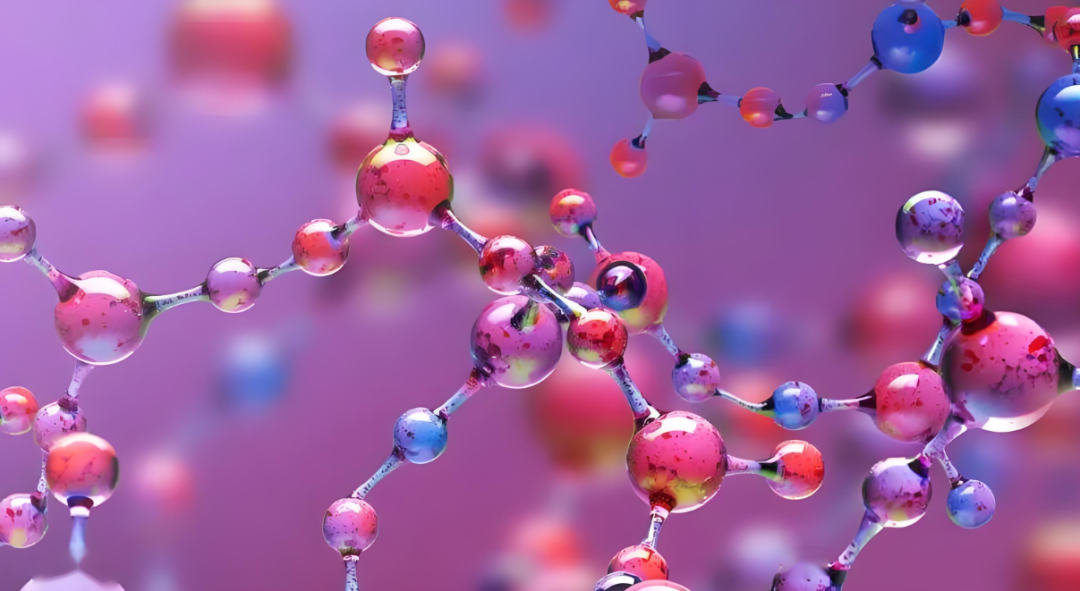
Editor | Green Luo
Synthesis of higher alcohols (HAS) through thermal catalytic hydrogenation of syngas remains a promising technology. Chain growth and CO insertion requirements require multicomponent materials whose complex reaction kinetics and broad chemical space do not meet catalyst design specifications.
Here, researchers from ETH Zurich propose an alternative strategy to integrate active learning into experimental workflows, using the FeCoCuZr catalyst series as an example.
The proposed data-assisted framework simplifies navigation of a wide space of compositions and reaction conditions across 86 experiments, reducing environmental footprint and cost by more than 90% compared to traditional procedures. It was determined that the Fe65Co19Cu5Zr11 catalyst with optimized reaction conditions achieved a higher alcohol productivity of 1.1 at stable operation for 150 hours, a 5-fold improvement over commonly reported yields.
at stable operation for 150 hours, a 5-fold improvement over commonly reported yields.
This approach goes beyond existing HAS catalyst design strategies, is applicable to a wider range of catalytic transformations, and promotes laboratory sustainability.
Related research titled "Active learning streamlines development of high performance catalysts for higher alcohol synthesis" was published on "Nature Communications" on July 11.
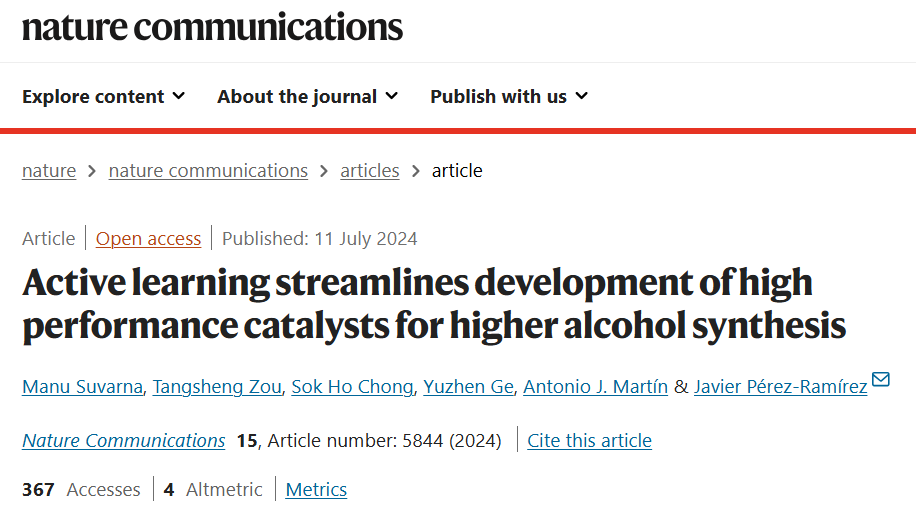
Developing efficient catalysts for syngas-based higher alcohol synthesis (HAS) remains a challenge A daunting research challenge that could reduce fossil fuel production of valuable chemicals and fuel additives while promoting a circular economy and mitigating climate change issues. Providing fossil fuels for the production of valuable chemicals and fuel additives.
The intersection of machine learning (ML) and parallel experimentation is active learning, which is suitable for accelerating materials design and process optimization through a small data-machine intelligence-human decision-making closed-loop framework.
Although this approach is increasingly popular in materials science, drug discovery, and biosystems engineering, it remains underexplored in the field of catalysis. Whether active learning-assisted methods are suitable for highly complex HAS catalyst systems is unknown.
Active learning accelerates catalyst development
In this study, researchers pioneered an active learning strategy to accelerate the development of highly active FeCoCuZr catalysts. The main features include:
(i) Fe65Co19Cu5Zr11 catalyst has high predictive ability, and its optimal reaction conditions are stable higher alcohols with a space-time yield (STYHA) of 1.1  and a duration of at least 150 h, which is Highest value reported so far for syngas direct HAS;
and a duration of at least 150 h, which is Highest value reported so far for syngas direct HAS;
(ii) Significant reduction in time and resources by identifying optimal systems for 86 experiments from a huge space of approximately 5 billion potential combinations;
(iii) More Targeted optimization reveals inherent performance trade-offs and recommends Pareto-optimal catalysts to minimize selectivity to CO2 and CH4 while still maintaining high STYHA.
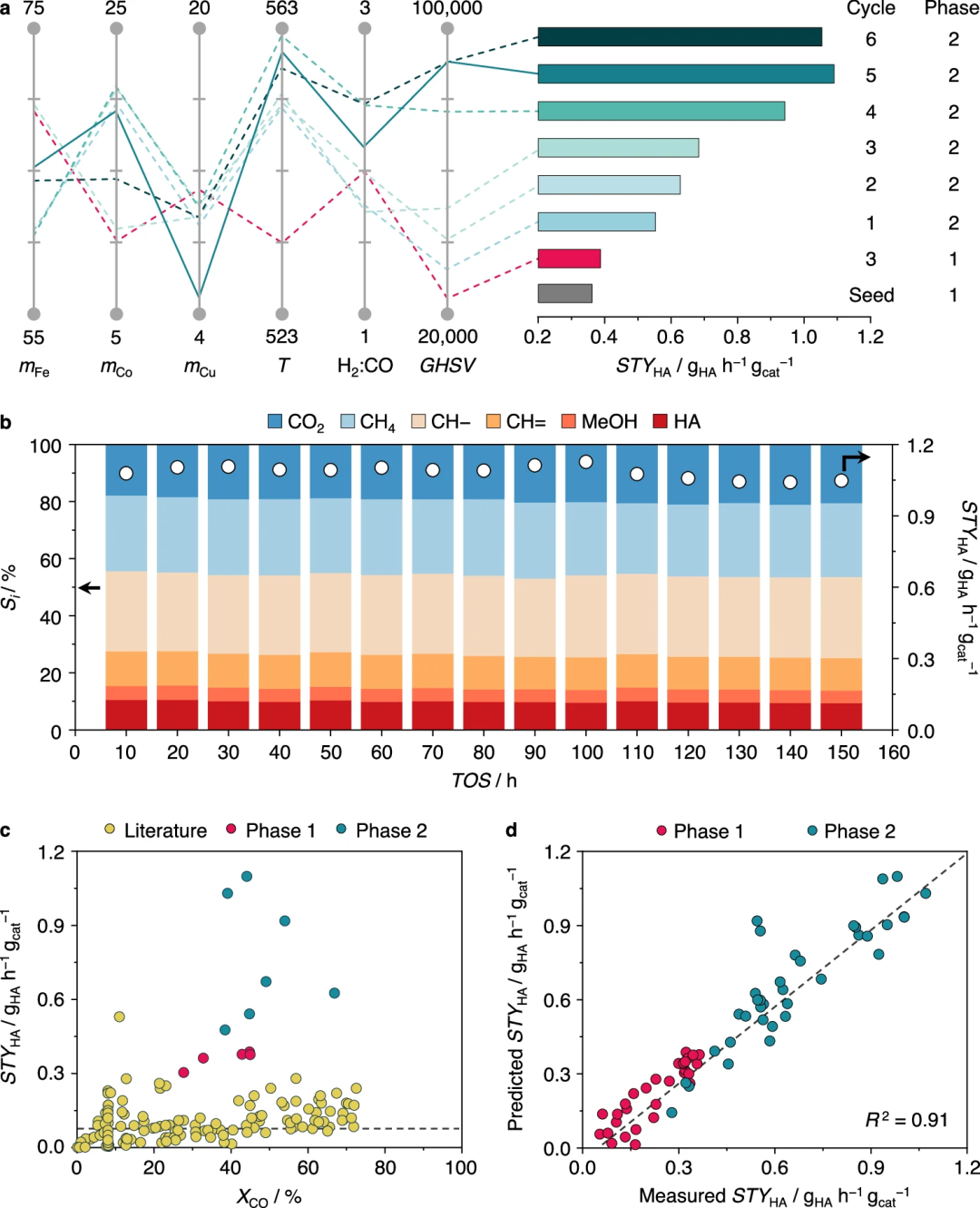
These results highlight the potential of data-driven approaches to continue to accelerate the development of efficient multicomponent catalysts and promote innovation in catalysis research.
Active Learning Framework Overview and Scope
Active learning approach that combines data-driven algorithms with experimental workflows that continuously learn from existing and newly generated data in iterative experimental cycles to explore and identify FeCoCuZr composition and reaction conditions to optimize the catalyst performance indicators of interest. The core of the data-driven model combines Gaussian Process (GP) and Bayesian Optimization (BO) algorithms with human decision-making to complete single or multi-objective tasks.
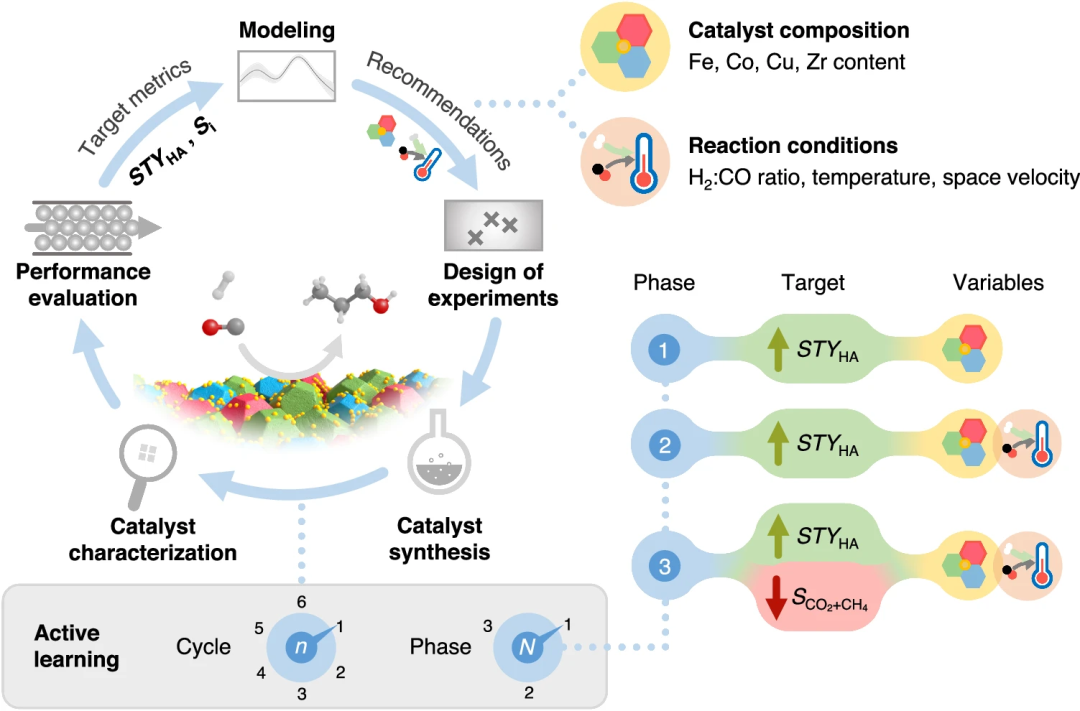
Illustration: Active learning workflow scheme for the development of FeCoCuZr catalyst. (Source: paper)
To demonstrate the feasibility of this approach for HAS, the study was conducted systematically in three different phases, gradually increasing the complexity of the model.
In stage 1, the catalyst composition is varied with the goal of maximizing STYHA under fixed reaction conditions.
In stage 2, the dimensionality of the problem is increased by simultaneously exploring catalyst composition and reaction conditions to maximize STYHA.
Then, in stage 3, the method is extended to multi-objective capabilities by simultaneously maximizing STYHA and minimizing the combined selectivity of CO2 and methane. Each stage performs an iterative cycle consisting of six experiments until the target performance index is reached or saturation is reached.
Active Learning and Sustainable Labs
While there are a billion combinations of possible chemistry and parameter space for FeCoCuZr systems, practical studies of multicomponent catalysts range from hundreds to thousands of screening experiments.
By employing active learning, the researchers mapped the vast space of FeCoCuZr catalysts into a cumulative 104 experiments in stages 1-3 to meet the required performance targets, confirming the growing literature claiming that active learning can speed up experiments Work. This has profound implications for the environmental and economic sustainability of catalyst development programs that have yet to be explored.
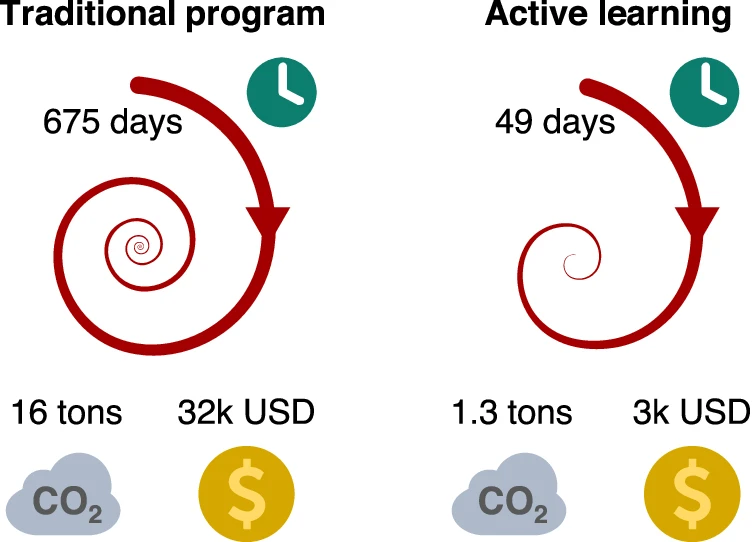
In this context, assuming that this study represents a catalyst development effort, the study evaluates the extent to which active learning affects two sustainability pillars of the laboratory.
Analysis shows that carbon footprint and costs are reduced by over 90% on average compared to traditional events. It was also observed that this result has very little dependence on global regional differences, affecting, for example, the energy mix or the composition of laboratory operating expenditures.
Thus, active learning significantly contributes to the development of sustainable catalysis laboratories by reducing the consumption of chemicals and energy, and optimizing resource utilization.
Note: The cover comes from the Internet
The above is the detailed content of Cost reduction by more than 90%, 'active learning + experimental workflow' accelerates catalyst development. For more information, please follow other related articles on the PHP Chinese website!

Hot AI Tools

Undresser.AI Undress
AI-powered app for creating realistic nude photos

AI Clothes Remover
Online AI tool for removing clothes from photos.

Undress AI Tool
Undress images for free

Clothoff.io
AI clothes remover

Video Face Swap
Swap faces in any video effortlessly with our completely free AI face swap tool!

Hot Article

Hot Tools

Notepad++7.3.1
Easy-to-use and free code editor

SublimeText3 Chinese version
Chinese version, very easy to use

Zend Studio 13.0.1
Powerful PHP integrated development environment

Dreamweaver CS6
Visual web development tools

SublimeText3 Mac version
God-level code editing software (SublimeText3)

Hot Topics
 1664
1664
 14
14
 1422
1422
 52
52
 1316
1316
 25
25
 1267
1267
 29
29
 1239
1239
 24
24
 Breaking through the boundaries of traditional defect detection, 'Defect Spectrum' achieves ultra-high-precision and rich semantic industrial defect detection for the first time.
Jul 26, 2024 pm 05:38 PM
Breaking through the boundaries of traditional defect detection, 'Defect Spectrum' achieves ultra-high-precision and rich semantic industrial defect detection for the first time.
Jul 26, 2024 pm 05:38 PM
In modern manufacturing, accurate defect detection is not only the key to ensuring product quality, but also the core of improving production efficiency. However, existing defect detection datasets often lack the accuracy and semantic richness required for practical applications, resulting in models unable to identify specific defect categories or locations. In order to solve this problem, a top research team composed of Hong Kong University of Science and Technology Guangzhou and Simou Technology innovatively developed the "DefectSpectrum" data set, which provides detailed and semantically rich large-scale annotation of industrial defects. As shown in Table 1, compared with other industrial data sets, the "DefectSpectrum" data set provides the most defect annotations (5438 defect samples) and the most detailed defect classification (125 defect categories
 Training with millions of crystal data to solve the crystallographic phase problem, the deep learning method PhAI is published in Science
Aug 08, 2024 pm 09:22 PM
Training with millions of crystal data to solve the crystallographic phase problem, the deep learning method PhAI is published in Science
Aug 08, 2024 pm 09:22 PM
Editor |KX To this day, the structural detail and precision determined by crystallography, from simple metals to large membrane proteins, are unmatched by any other method. However, the biggest challenge, the so-called phase problem, remains retrieving phase information from experimentally determined amplitudes. Researchers at the University of Copenhagen in Denmark have developed a deep learning method called PhAI to solve crystal phase problems. A deep learning neural network trained using millions of artificial crystal structures and their corresponding synthetic diffraction data can generate accurate electron density maps. The study shows that this deep learning-based ab initio structural solution method can solve the phase problem at a resolution of only 2 Angstroms, which is equivalent to only 10% to 20% of the data available at atomic resolution, while traditional ab initio Calculation
 NVIDIA dialogue model ChatQA has evolved to version 2.0, with the context length mentioned at 128K
Jul 26, 2024 am 08:40 AM
NVIDIA dialogue model ChatQA has evolved to version 2.0, with the context length mentioned at 128K
Jul 26, 2024 am 08:40 AM
The open LLM community is an era when a hundred flowers bloom and compete. You can see Llama-3-70B-Instruct, QWen2-72B-Instruct, Nemotron-4-340B-Instruct, Mixtral-8x22BInstruct-v0.1 and many other excellent performers. Model. However, compared with proprietary large models represented by GPT-4-Turbo, open models still have significant gaps in many fields. In addition to general models, some open models that specialize in key areas have been developed, such as DeepSeek-Coder-V2 for programming and mathematics, and InternVL for visual-language tasks.
 Google AI won the IMO Mathematical Olympiad silver medal, the mathematical reasoning model AlphaProof was launched, and reinforcement learning is so back
Jul 26, 2024 pm 02:40 PM
Google AI won the IMO Mathematical Olympiad silver medal, the mathematical reasoning model AlphaProof was launched, and reinforcement learning is so back
Jul 26, 2024 pm 02:40 PM
For AI, Mathematical Olympiad is no longer a problem. On Thursday, Google DeepMind's artificial intelligence completed a feat: using AI to solve the real question of this year's International Mathematical Olympiad IMO, and it was just one step away from winning the gold medal. The IMO competition that just ended last week had six questions involving algebra, combinatorics, geometry and number theory. The hybrid AI system proposed by Google got four questions right and scored 28 points, reaching the silver medal level. Earlier this month, UCLA tenured professor Terence Tao had just promoted the AI Mathematical Olympiad (AIMO Progress Award) with a million-dollar prize. Unexpectedly, the level of AI problem solving had improved to this level before July. Do the questions simultaneously on IMO. The most difficult thing to do correctly is IMO, which has the longest history, the largest scale, and the most negative
 PRO | Why are large models based on MoE more worthy of attention?
Aug 07, 2024 pm 07:08 PM
PRO | Why are large models based on MoE more worthy of attention?
Aug 07, 2024 pm 07:08 PM
In 2023, almost every field of AI is evolving at an unprecedented speed. At the same time, AI is constantly pushing the technological boundaries of key tracks such as embodied intelligence and autonomous driving. Under the multi-modal trend, will the situation of Transformer as the mainstream architecture of AI large models be shaken? Why has exploring large models based on MoE (Mixed of Experts) architecture become a new trend in the industry? Can Large Vision Models (LVM) become a new breakthrough in general vision? ...From the 2023 PRO member newsletter of this site released in the past six months, we have selected 10 special interpretations that provide in-depth analysis of technological trends and industrial changes in the above fields to help you achieve your goals in the new year. be prepared. This interpretation comes from Week50 2023
 To provide a new scientific and complex question answering benchmark and evaluation system for large models, UNSW, Argonne, University of Chicago and other institutions jointly launched the SciQAG framework
Jul 25, 2024 am 06:42 AM
To provide a new scientific and complex question answering benchmark and evaluation system for large models, UNSW, Argonne, University of Chicago and other institutions jointly launched the SciQAG framework
Jul 25, 2024 am 06:42 AM
Editor |ScienceAI Question Answering (QA) data set plays a vital role in promoting natural language processing (NLP) research. High-quality QA data sets can not only be used to fine-tune models, but also effectively evaluate the capabilities of large language models (LLM), especially the ability to understand and reason about scientific knowledge. Although there are currently many scientific QA data sets covering medicine, chemistry, biology and other fields, these data sets still have some shortcomings. First, the data form is relatively simple, most of which are multiple-choice questions. They are easy to evaluate, but limit the model's answer selection range and cannot fully test the model's ability to answer scientific questions. In contrast, open-ended Q&A
 The accuracy rate reaches 60.8%. Zhejiang University's chemical retrosynthesis prediction model based on Transformer was published in the Nature sub-journal
Aug 06, 2024 pm 07:34 PM
The accuracy rate reaches 60.8%. Zhejiang University's chemical retrosynthesis prediction model based on Transformer was published in the Nature sub-journal
Aug 06, 2024 pm 07:34 PM
Editor | KX Retrosynthesis is a critical task in drug discovery and organic synthesis, and AI is increasingly used to speed up the process. Existing AI methods have unsatisfactory performance and limited diversity. In practice, chemical reactions often cause local molecular changes, with considerable overlap between reactants and products. Inspired by this, Hou Tingjun's team at Zhejiang University proposed to redefine single-step retrosynthetic prediction as a molecular string editing task, iteratively refining the target molecular string to generate precursor compounds. And an editing-based retrosynthetic model EditRetro is proposed, which can achieve high-quality and diverse predictions. Extensive experiments show that the model achieves excellent performance on the standard benchmark data set USPTO-50 K, with a top-1 accuracy of 60.8%.
 Nature's point of view: The testing of artificial intelligence in medicine is in chaos. What should be done?
Aug 22, 2024 pm 04:37 PM
Nature's point of view: The testing of artificial intelligence in medicine is in chaos. What should be done?
Aug 22, 2024 pm 04:37 PM
Editor | ScienceAI Based on limited clinical data, hundreds of medical algorithms have been approved. Scientists are debating who should test the tools and how best to do so. Devin Singh witnessed a pediatric patient in the emergency room suffer cardiac arrest while waiting for treatment for a long time, which prompted him to explore the application of AI to shorten wait times. Using triage data from SickKids emergency rooms, Singh and colleagues built a series of AI models that provide potential diagnoses and recommend tests. One study showed that these models can speed up doctor visits by 22.3%, speeding up the processing of results by nearly 3 hours per patient requiring a medical test. However, the success of artificial intelligence algorithms in research only verifies this



